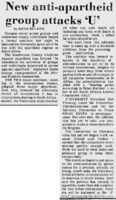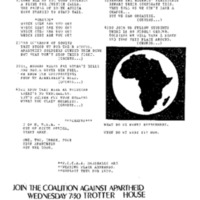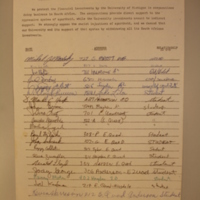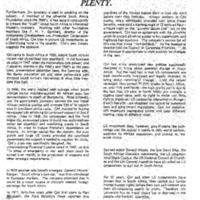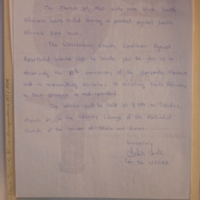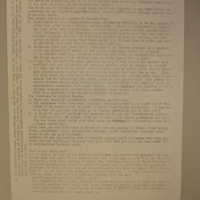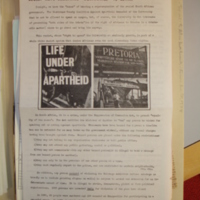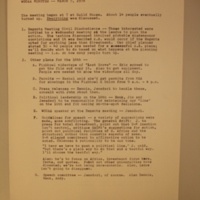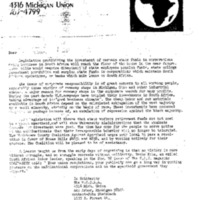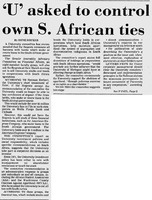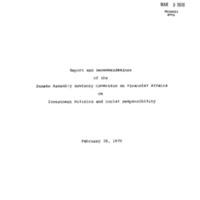Washtenaw County Coalition Against Apartheid
UM anti-apartheid activists formed the Washtenaw County Coalition Against Apartheid (WCCAA) in the fall of 1977, six months after campus activist leaders had called for divestment at the Board of Regents meeting in May. The UM anti-apartheid movement's momentum had been maintained over the summer when a small group of students gathered that June on the Diag to protest the sale of the South African Krugerrand gold coin. When the Fall 1977 semester began, campus anti-apartheid leaders again called for an investigation of UM investments at the September Regents’ meeting. Then, in November, the African Students' Association (ASA) held a teach-in on South Africa, part of a series of apartheid awareness-raising events that semester. An ASA spokesperson said that the group was "hoping that this teach-in provides the kind of educational material and political information on campus so these issues are better covered." On November 28, in response to the teach-in, the ASA joined with multiple groups on campus and with activists in the Ann Arbor community to create the Washtenaw County Coalition Against Apartheid. The founding organizations included the People’s Action Coalition, the Black Student Union, the Afro-American Students Association, and the Young Socialists Alliance. The WCCAA formed and held its meetings at the Guild House in Ann Arbor, a longtime center of progressive political activism that linked the campus and community. A network of students, faculty, and local community activists, the WCCAA quickly moved into the central leadership position of the anti-apartheid campaign to pressure the University of Michigan to divest.
The founding documents of the WCCAA explain the group’s mission. Their main goal was ending U.S. government and corporate support for the white minority government in South Africa. Additionally, they wanted to promote self-determination for the people of South Africa and support African liberation movements. The WCCAA was also interested in equality at home. They wanted a “non-racist, non-sexist, fully democratic, and economically just United States.” In reflection of this goal, they wanted their coalition to be made up of “diverse organizations, groups, and individuals.”
When it came to racial diversity, the WCCAA was not always able to meet its goal. Despite the WCCAA’s association with several black student groups, a majority of its membership was white and sometimes there were not as many black students and community members at their protests as the group would have liked. However, the Coalition remained aware of this and tried hard to create a diverse organization. In addition, the WCCAA made sure to include minority students in its leadership positions.
In order to spread its message, bring more people to its cause, and put pressure on University administrators to divest, the WCCAA used many different tactics. They wrote letters, circulated petitions, hung flyers and posters, held rallies and protests, and canvassed in the dorms and distributed educational materials. Debi Duke, a core member of the WCCAA, recalls in a 2015 interview:
Through WCCAA we aimed to educate ourselves and others about apartheid and colonialism and to act on our understanding. In particular, we felt some responsibility for the role our country played in the developing world. Our primary goal was to get the University to divest itself of companies doing business in South Africa. In those days before the Internet that meant organizing forums, writing letters and articles, leafleting, demonstrating, and the like as, well as raising funds to support those efforts and to support liberation movements abroad.
Some of the ways the WCCAA spread their message.
The scope of the WCCAA's activism extended beyond UM's campus. They became involved in anti-apartheid activities in the city of Ann Arbor, the state of Michigan, and the nation. In a 2015 interview, Heidi Gottfried, a founding member, discusses how the WCCAA became an organizer not only on the University of Michigan campus, but on a national scale.
But I would say we were, and maybe its just hubris on my part, because it is from my point of view, that we were the organizers of a lot of those activities. Certainly in terms of interuniversity relationships. We tied together MSU, people at Wayne State, Grand Valley State University. We helped organize the regional conference that took place at Northwestern and this was around Dennis Brutus, the South African poet. Again, a central figure nationally in the anti-Apartheid movement because he is from South Africa and he was an exile from South Africa, so he was involved in liberation movements there so he kind of represented the ANC in exile in a sense, not officially. And so we had a regional conference at Northwestern,which brought together people from the state of Michigan, many of the institutions of the midwest, people from the east coast, activists from anti-Apartheid movements sent delegates to our conference and through that delegation, we helped to organize a conference on the east coast.
Engaging the University
As the WCCAA and other student protesters brought increased pressure on the administration, the University was compelled to respond. The University’s first major response was to hold a University Forum on Corporate Investment in South Africa. The four day Forum, held in late January of 1978, brought together speakers from the University community, the nation, and the world for panel discussions and debates. The participants included professors, representatives of national anti-apartheid organizations, General Motor’s director of Overseas Public Relations, members of the African National Congress, and representatives of the South African Embassy. They discussed South Africa and the Apartheid system, U.S. government and corporate policy toward South Africa, and the University’s options for its investments in companies operating in South Africa. As a result of the presence of representatives of the South African Apartheid government, the Forum became a target for student protest. Members of the WCCAA and other activist groups picketed the Forum and interrupted the representative of the South African Consulate. The students wanted action, not academic debate. After the Forum ended, the Committee on Communications, who sponsored the event, issued a report concluding that the majority of the University community favored divestment.
Faced with a growing consensus on campus that the University needed to reexamine its stockholdings in companies operating in South Africa, the Regents realized they needed to create an official policy on investments. In order to help them make a decision, the Regents tasked the Senate Advisory Committee on Financial Affairs (SACFA) with examining the issue and drawing up an investment policy for the University. The Committee released their report just before the March, 1978 Regents meeting. In the report, the Advisory Committee recommended ending all business with banks that make loans to the South African government. However, to the disappointment of the WCCAA and other student protesters, the Committee advised the University to keep its stocks in companies doing business in South Africa. The report suggested the University use its voting rights as a shareholder to try to influence corporate activities in South Africa. They also recommended that the University only invest in companies that follow the guidelines laid out in the Sullivan Principles. The student activists were disappointed with the report. WCCAA activist and student representative on the Committee on Communications Heidi Gottfried doubted the University’s ability to influence corporate policy. In an interview with the Michigan Daily she said, “Could the University be an effective and active shareholder? Personally, I don’t think they can.” In response, the WCCAA wrote a dissenting report that blasted the Advisory Committee’s recommendations and called for full divestment. The WCCAA’s report stated: “Stockholders’ resolution and statements to management have not prevented the Soweto riots, the murder of Steve Biko, Afrikaner intransigence and increasing repression. Only divestiture can speak to the reality of South Africa today. Divestiture, bluntly, is ‘putting your money where your mouth is.’” The stage was set for a confrontation between the Regents and student activists.
Sources for this page:
The Michigan Daily, May 20, 1977.
The Michigan Daily, June 17, 1977.
The Michigan Daily, September 16, 1977.
The Michigan Daily, 6 November 6, 1977.
The Michigan Daily, November 29, 1977.
The Michigan Daily, January 29, 1978.
The Michigan Daily, Februrary 1, 1978.
The Michigan Daily, February 14, 1978.
The Michigan Daily, March 3, 1979.
The Michigan Daily, April 21, 1979.
"History of the Washtenaw County Coalition Against Apartheid," 1977, WCCAA Minutes and Administrative Records 1978-1979, Box 5, Center for Afroamerican and African Studies records, Bentley Historical Library, University of Michigan
"Response of the WCCAA to SACFA," March 8, 1978, S Africa Investments Background Material 1978, Box 7, Thomas Roach papers, Bentley Historical Library, University of Michigan
Interview of Debi Duke by Emily Bodden, March 25, 2015, via email.


